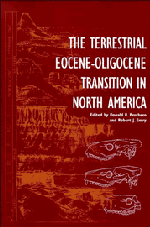Book contents
- Frontmatter
- Contents
- Contributors
- Preface
- PART I The Chronostratigraphy of the Uintan through Arikareean
- PART II Common Vertebrates of the White River Chronofauna
- 16 Testudines
- 17 Squamata
- 18 Ischyromyidae
- 19 Cylindrodontidae
- 20 Castoridae
- 21 Canidae
- 22 Nimravidae
- 23 Amphicyonidae
- 24 Small Arctoid and Feliform Camivorans
- 25 Merycoidodontinae and Miniochoerinae
- 26 Leptaucheniinae
- 27 Leptomerycidae
- 28 Camelidae
- 29 Hyracodontidae
- Summary
- Index
26 - Leptaucheniinae
Published online by Cambridge University Press: 06 July 2010
- Frontmatter
- Contents
- Contributors
- Preface
- PART I The Chronostratigraphy of the Uintan through Arikareean
- PART II Common Vertebrates of the White River Chronofauna
- 16 Testudines
- 17 Squamata
- 18 Ischyromyidae
- 19 Cylindrodontidae
- 20 Castoridae
- 21 Canidae
- 22 Nimravidae
- 23 Amphicyonidae
- 24 Small Arctoid and Feliform Camivorans
- 25 Merycoidodontinae and Miniochoerinae
- 26 Leptaucheniinae
- 27 Leptomerycidae
- 28 Camelidae
- 29 Hyracodontidae
- Summary
- Index
Summary
ABSTRACT
The Leptaucheniinae previously have been split into 7 genera and 31 species. Using a combination of bivariate and multivariate statistics and shared derived characters, the species of Leptaucheniinae from the northern Great Plains are re-evaluated, and a new classification is suggested. This classification recognizes the genera Leptauchenia Leidy and Sespia Stock. The two genera can be distinguished on the basis of skull size, dental features, and orbit size. Leptauchenia contains two species, L. decora and L. major. These species are separated by differences in dental formula, auditory bullae volume, orbit area, and orbital bridge width. The only Sespia from the Great Plains is Sespia nitida. This interpretation of the Leptaucheniinae restricts the use of these taxa in the biostratigraphy of the Northern Great Plains.
INTRODUCTION
The subfamily Leptaucheniinae of the family Merycoidodontidae is a small group of Oligocene oreodonts characterized by the presence of a long nasalfacial vacuity, high crowned teeth and large auditory bullae (Fig. 1). They have been known from the northern Great Plains since the 1850s (Leidy, 1856). Since that time, the group has undergone several systematic revisions (Thorpe, 1921, 1937; Scott, 1940). The most recent treatment, Schultz and Falkenbach (1968), left the group oversplit into 7 genera and 31 species. In this chapter, I suggest that many of the characters used by Schultz and Falkenbach and others to define groups within the Leptaucheniinae are strongly correlated to skull size and are therefore not useful for taxonomic purposes.
- Type
- Chapter
- Information
- The Terrestrial Eocene-Oligocene Transition in North America , pp. 574 - 580Publisher: Cambridge University PressPrint publication year: 1996
- 1
- Cited by



